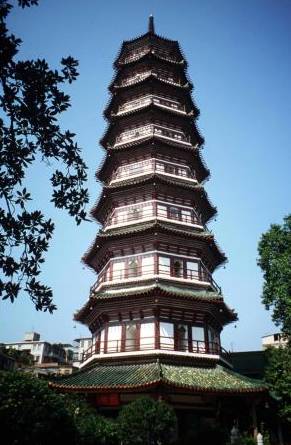Liurong Temple
Situated northwest of 6th Zhongshan Road in downtown Guangzhou, the Liurong Temple was built in during the Liang Dynasty (502-557). It is one of the famous ancient landmarks of Guangzhou.
In 537, Emperor Wu of Liang (the most famous Buddhist emperor in Chinese history) had his uncle, monk Tanyu, obtain Buddhist relics from Kampuchea and bring them to Guangzhou. A temple was specially built to store the relics. The Song Dynasty (960-1279) poet Su Shi visited the temple and, noticing six banyan trees growing there, nicknamed it "Liu Rong" (Six Banyans). The inscription of these words at the entrance to the temple is in the poet’s calligraphy. The temple was officially named Six-Banyan Temple in the Ming Dynasty.
The Flower Pagoda is the major structure of the temple. The temple also houses a portrait of Su Shi, three huge statues made of brass in early Qing Dynasty and a statue of Monk Huineng (638-713), who was the Sixth Patriarch of Zen Buddhism and the founder of the doctrine of sudden enlightenment.
[[category:tourism]
